Content
- 1 When can you plant summer garlic, timing
- 2 How to plant in open ground in spring
- 3 Growing and caring for the future harvest and the first shoots
- 4 Cleaning and storage
- 5 About garlic
- 6 Varieties
- 7 Sowing technology
- 8 Video "Planting garlic in the garden in the spring"
- 9 Care
- 10 Pest and disease control
- 11 Cleaning and storage
- 12 Video "Super idea for planting garlic"
- 13 General sowing rules
- 14 Pests and diseases
- 15 Preventive measures
- 16 Top dressing and seed treatment
- 17 Landing features
- 18 Harvesting
Garlic belongs to the onion family... It is widely used in cooking and traditional medicine. The plant has a piquant taste and smell, and is an excellent antiseptic. Its agricultural technology is quite simple. and its cultivation is not a problem even for inexperienced gardeners. In this article, we'll talk about planting summer garlic in the spring.
When can you plant summer garlic, timing
There are two groups of garlic - summer and winter, they are also called spring and winter. The division of groups is very simple - according to the dates of planting.
The differences between them are as follows:
- winter forms arrows with air bulbs, through which it multiplies; summer arrow does not form and reproduces by denticles;
- the summer bulb has a large number of cloves (up to 30 pieces), the winter bulb has about 10 cloves;
- the main advantage of the summer one is the long shelf life; it can be stored until the next harvest;
- planting dates for summer garlic: late April - early May, winter: mid-autumn.
To get a good harvest, it is necessary to plant summer garlic in open ground after the soil reaches a temperature above + 5-6 ° C.
This is explained by the formation and active growth of its roots and leaves occurs only at low temperatures.
If the timing is shifted even by 1-2 weeks, the leaves and roots stop their active development, which will negatively affect the harvest.
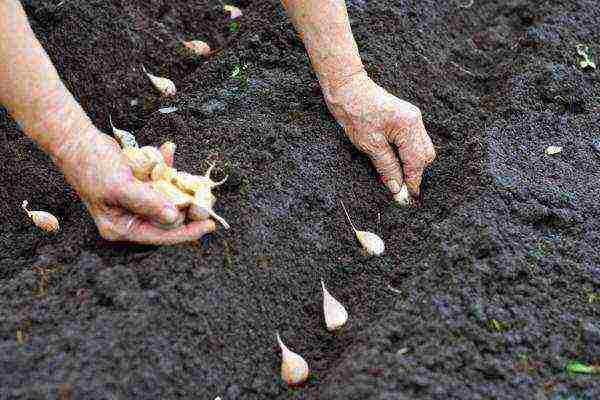 Planting dates for spring crops - late April – early May, winter crops - mid-autumn
Planting dates for spring crops - late April – early May, winter crops - mid-autumn
How to plant in open ground in spring
Correct site for planting summer garlic should be on the sunny side. The soil should be fertile, with a neutral environment.
Acidic soils require ash liming. The crop grows best on loamy soil..
Preparing the bulbs for planting
Warm storage bulbs (stored at room temperature) are slightly immature. 2 months before planting, they are placed in the refrigerator.
With cold bulbs (cellar) storage, such a procedure is not necessary.
Before planting, the cloves are examined and only healthy and strong ones are selected. At the same time, the sick, deformed and degenerated (with two tops) are screened out.
After that, the selected cloves are sorted by size.
All teeth are disinfected solution of copper sulfate. For 8 hours before planting, the teeth are soaked in a warm solution of nitroammophos; the concentration is 5 g per 10 l of water.
 Before planting, the cloves are examined, healthy and strong are selected, diseased and with two tops are weeded out
Before planting, the cloves are examined, healthy and strong are selected, diseased and with two tops are weeded out
Preparing the beds
The precursors to garlic can be legumes or cruciferous plants. Also, the culture takes root well on soils where pumpkins or cucumbers were cultivated before it.
The use of nightshades (potatoes, tomatoes) as precursors is undesirable due to infectious contamination of garlic.
Since the root system of the bulbs is small, the beds for him should not be more than 15 cm high... The width of the beds is chosen from 80-90 cm.
Before landing, it is advisable water the beds with saline (150 g of salt per 10 liters of water).
How to plant
Prerequisite make furrows on the beds 5-8 cm deep... Landing is done with the tip of the clove to the top.
It is necessary to plant it in the ground to a depth of 2-3 cm from the surface to the tip of the prong. The distance between the teeth is about 10 cm, between the rows - 15 cm. Large teeth are planted separately from small and medium ones.
After planting and covering the teeth with earth, it is necessary to feed the beds with ammonium sulfate (20 g per 10 l of water) in order to prevent pests from spoiling the seed.
Spring planting of garlic:
Growing and caring for the future harvest and the first shoots
After the first shoots appear the culture needs care and feeding. Nitrogenous fertilizers are preferred.
The typical composition of the mixture is as follows: in ten liters of water, it is necessary to dissolve 25 g of urea and a glass of mullein.
The calculation of the required amount of complementary foods is determined based on the sowing area: per 1 sq. you need 3 liters of the mixture. After 10 days, feeding is repeated.
 After the first shoots appear, feed them with nitrogenous fertilizers
After the first shoots appear, feed them with nitrogenous fertilizers
During May and June, the beds must be watered every 5-6 days.... During this period, watering is carried out once, but in such a way that the soil is moistened all the time.
During the entire growing season, it is necessary to loosen the beds and remove weeds from them... Loosening is done the next day after watering.
As soon as the bulbs begin to form, it must be fed with phosphorus-potassium fertilizer.
To do this, prepare a solution consisting of 10 liters of water, 80 g of double superphosphate and 35 g of potassium chloride. The approximate consumption of the composition is 5 liters per 1 sq.
After 10 days, fertilization is repeated.... In the interval between applications, preferably on the 3rd day, wood ash is added to the soil.
Even when planted at the end of April, the garlic does not always ripen. It is necessary to control the degree of maturity of the bulb by leaves from the end of July.
If they begin to dry out in early August, the garlic has time to ripen. If the leaves are still fresh during this period, its ripening should be accelerated.
There are two ways to speed up the ripening of the bulbs.... The first is to partially pull the bulbs out of the ground. In this case, some of the roots are injured, and all the forces of the plant go not to the growth of the leaves, but to the ripening of the bulb.
In the second method, the leaves of each bulb are tied in a knot, their growth stops, and nutrients begin to intensively accumulate in the bulb. Any of these procedures are performed in mid-August.
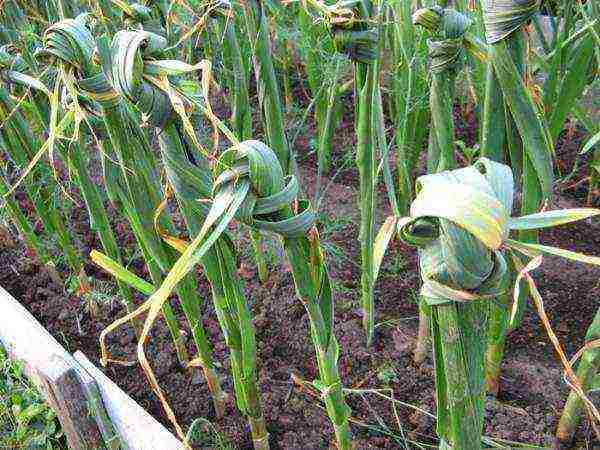 You can accelerate the ripening of the bulbs by tying the leaves at each knot
You can accelerate the ripening of the bulbs by tying the leaves at each knot
Diseases and pests
The main crop pests are onion fly and black mold... And although garlic has an excellent protective function, it is advisable to monitor its condition.
Helps with onion fly watering with saline (200 g of salt per 10 liters of water).
Against black mold fungus well recommended spraying plants with Bordeaux mixture.
Cleaning and storage
Traditionally, the crop is harvested in mid-September... After harvesting, the plants are dried: the first hour in the garden, then under a canopy or in a well-ventilated area.
You cannot dry garlic in the sun. This is fraught with sunburn and reduced shelf life.
He is tied in braids and dried in limbo.... At the end of the drying process, it is sent for storage, after cutting off the dry leaves at a distance of 5-7 cm from the top of the head.
Store garlic in the coldest corner of the apartment (warm storage) or in the basement or refrigerator with a temperature of + 1-5 ° C (cold storage).
Tips for harvesting and storing garlic:
Garlic is not just a hot spice, but also a means of preventing and treating many diseases. Therefore, almost all summer residents and vegetable growers plant this crop in their gardens.Growing garlic outdoors is usually straightforward. However, in order to obtain a high and long-term storage yield, it is necessary to observe a number of rules and agricultural techniques for the cultivation of this useful crop.
About garlic
Garlic is a perennial bulbous plant with a ground herbaceous stem and an underground part - a complex bulb consisting of several teeth. The taste of the pulp is pungent, bitter and very spicy. The taste, as well as the characteristic odor, are due to the presence in the plant of thioesters - organic compounds that combine the properties of ethers and alcohols. It is these substances that endow the plant with a pronounced antiseptic effect.
The roots of the garlic are fibrous, located at the bottom of the bulb. The bulb itself consists of 4-30 lobules (teeth), covered with dense scales. The leaves of the plant are narrow (1–2 cm wide), long (30–100 cm), germinate one from the other, forming a persistent stem, which softens when ripe.
Peduncles are umbrella-shaped arrows with a complex inflorescence at the top, from which a seed box with multiple bulbs is then formed - seed material. The main nutritional value of the plant is concentrated in the teeth, but in young garlic, the stems and even the arrows with peduncles are also edible.
The story tells that the cultivation of garlic took place in the mountainous regions of Central Asia, which is considered the birthplace of the plant. Research has confirmed that garlic was derived from long-pointed onions that grow in the wild at the bottom of mountain gorges.
To date, many varieties have been bred, but up to 30 varieties of domestic and foreign selection are cultivated for economic needs.
Varieties
Garlic is classified into two types:
- Winter (winter). It is planted in autumn and harvested next summer. It easily tolerates even severe frosts, has a high yield, but is not stored for long.
- Spring (summer). Planting is carried out in the spring. Its heads are not as large as those of a winter crop, but it can be stored until the next harvest.
Winter varieties are quite unpretentious, and almost any of them can be grown outdoors. However, planting of the following varieties is most often recommended:
- Losevsky is a mid-season variety, included in the State Register as a crop of agricultural importance, is distinguished by high frost resistance, the heads are large (up to 75 g), contain 5-6 cloves each, stored for up to 6 months;
- Gribovskiy is an early ripening variety prone to shooting, medium-sized heads with 7–11 teeth, highly resistant to diseases and weather conditions;
- Komsomolets is a mid-season shooting variety, the heads are dense, contain 6–12 cloves, covered with pinkish scales, resistant to cold;
- The doctor is a mid-season non-shooting variety, the heads are dense, contain up to 16 cloves, it is stored for a long time, it is well transported;
- Jubilee - a variety of the middle ripening period, prone to the formation of arrows, has a high yield and resistance to diseases, the heads are large, consist of 10-12 cloves.
Among the spring varieties, the most common are:
- Gulliver is a mid-season variety with massive heads (90-120 g), slightly flat in shape, containing 3-5 large teeth, covered with gray scales, white flesh, very sharp, can be stored for more than 8 months;
- Victorio is a moderately spicy mid-season variety, included in the State Register as a crop grown in vegetable gardens, medium-sized bulbs (up to 40 g), contain 10-13 cloves, stored for up to 8 months;
- Elenovsky is a recently bred, but already very popular variety, small bulbs (25-40 g), consist of 7-10 prongs, is highly resistant to frost and disease, stored for up to 2 years, both spring planting and winter planting are possible ;
- Sichinsky is an early maturing (80–92 days) variety, the weight of the heads is 40–45 g, the teeth are white, dense, slightly sharp, the plants are resistant to cold and disease, the shelf life of the heads is 1.5 years.
Sowing technology
Agricultural technology of winter and spring garlic differs only in terms of planting, but otherwise the process of growing and care is practically the same.
When to plant
Summer (spring) varieties are planted very early - as soon as the snow melts. As a rule, this moment occurs at the beginning of April. Garlic is quite frost-hardy and can thrive in cold soil.
In the course of repeated observations, it was noted that the roots of the plant are able to germinate as soon as the soil warms up to 2-3 ° C, and the shoots begin to grow at a temperature of 5-6 ° C, while the vegetative process stops in the summer heat.
Planting crops for the winter is carried out no earlier than the soil temperature drops to 8-10 ° C. This usually occurs during the time period from late September to mid-October. Planting during this period is considered optimal, since the plants have time to form a root system before frost, but the vegetative process does not have time to begin.
Soil and seed preparation
The area for garlic should be flat and open to the sun. It is imperative to observe the order of crop rotation - it is not recommended to plant garlic on the same bed for more than 2 years in a row. It is also important to consider who was the predecessor of the culture - it is easiest to grow garlic in the area where cucumbers, zucchini, cabbage, any beans grew.
The soil for sowing should be fertile enough, with neutral acidity (in extreme cases, slightly alkaline), with good drainage properties.
If the soil in the garden is slightly acidic, the site needs to be limed, and if the soil is heavy, mix it with sand or peat.
For both winter and spring varieties, the soil is prepared in the fall. In this case, the site is dug to a depth of at least 30 cm, and the soil is filled with organic fertilizers along with ready-made mixtures. For example, for every 1 m², you can add 1 bucket of humus, 30 g of superphosphate and 20 g of potassium salts.
It is interesting to know that some gardeners, before sowing the teeth, process (water) the soil with saline in a ratio of 1 glass of salt to 1 bucket of warm water. The salt must be completely dissolved in water, and when the solution cools down, use it to water the garden. They note that such disinfection helps to get rid of pests that live in the soil and makes it easier to take care of the plants further.
Preparing the soil is half the battle. It is equally important to properly prepare the seeds intended for sowing. Basically, the process of preparing garlic for sowing is stratification. The procedure involves keeping the teeth in a cold and humid environment for 2-4 weeks. During this time, the seeds will begin embryonic sleep, after which, once in warm soil, they will begin to grow intensively.
At the end of stratification, the teeth are sorted by size, selecting the largest, even and healthy ones. Then the selected material is disinfected in an ash solution: 200 g of ash / 1 liter of water is boiled for half an hour, then cooled. The teeth are kept in this solution for two hours, after which they are wrapped in a damp cloth and germinated at room conditions. Such careful preparation is needed for summer varieties; winter crops do not need stratification and germination.
Landing
This process is the same for both types of garlic, with the only difference that the planting of winter varieties is carried out immediately after the preparation of the garden, and for spring varieties, the site needs to be loosened again two weeks before sowing and, if necessary, watered.
Further, longitudinal furrows of arbitrary length are made in the soil, on the bottom of which a 2, 3-centimeter layer of ash or sand is poured - this is necessary in order to prevent the contact of seeds with the soil, and thereby protect them from rotting.In this soil mixture, the teeth are buried bottom down.
The distance between the teeth depends on their size. The teeth of winter garlic are larger, so they are planted at a distance of 10-15 cm from each other, the teeth of summer varieties are smaller - for them the optimal distance will be 7-10 cm. After planting, the teeth are covered with earth and a little compacted. To facilitate the care of winter garlic, the beds are mulched with sawdust or peat.
Video "Planting garlic in the garden in the spring"
This video is about planting spring garlic. You will learn small secrets for a successful planting and rich harvest.
Care
Further care of the culture consists of the following activities:
- Watering. The plant is watered as needed. In extreme heat, when the soil dries up, watering should be abundant - 10 l / 1 m². There is no need to water the beds during rains. Also, watering should be stopped 2-3 weeks before harvest.
- Loosening the soil. Caring for summer varieties involves regular weeding and weeding. Winter garlic is usually mulched, so loosening is not necessary.
- Top dressing. During the spring-summer period, the plants are fed 3-4 times: in the middle of the growing season, when the height of the stems reaches 15 cm - with organic matter (mullein), at the stage of head formation - with nitrophosphate, a couple of weeks before harvesting - with superphosphate.
- Breaking off arrows (relevant for winter varieties). Such care is necessary for the growth of large heads.
Despite the fact that most varieties of garlic are quite resistant to diseases and pests, plants are often attacked by fungi, bacteria or insects, so caring for the crop is also about fighting them.
Pest and disease control
The following diseases are dangerous for plants:
- powdery mildew - the stems turn yellow and become covered with brown spots;
- bacteriosis - yellow-brown ulcers form on the teeth;
- white rot - the leaves begin to turn yellow at the tips, and then gradually die off;
- rust - yellow dry spots on the leaves.
Garlic can be affected by diseases not only in the garden, but also during storage:
- cervical rot - rotting of the neck of the head;
- fusarium is a white bloom on the bottom of the head, causing a putrefactive process.
Care and control of these problems consists in the use of insecticides and other similar drugs. But you need to understand that garlic, being in the ground, absorbs all this chemistry, which can subsequently affect the health of the culture. Therefore, the fight against diseases consists, first of all, in preventive measures: observance of crop rotation, treatment of the storage with bleach, sufficient warming of the garlic heads.
As for pests, most often garlic is eaten by ticks, onion moths, caterpillars, bears, and centipedes. You can fight this living creature with the help of organic solutions: ash, whey and other folk remedies. In this case, the care consists in spraying the beds with regularity once a week.
Cleaning and storage
For successful storage, it is important not only to grow the garlic correctly, but also to harvest it in a timely manner. Winter varieties are dug up in mid-July - early August, summer varieties 2-3 weeks later - at the end of August.
Use a garden fork or a small shovel to dig up the bulbs. You need to start harvesting in the morning in dry and warm weather, so that during the day the heads can dry out in the garden. At the end of the day, the crop must be carried under a canopy or in a dry room for further ripening.
Garlic is stored in a cool dry place with a humidity of 60-80%. It has been noticed that the heads remain suspended longer. To do this, they are collected in bunches, braids are woven, and placed in nets. You can also store the heads in cardboard boxes, but more correctly - in wicker baskets, as they provide good ventilation. Depending on the storage method, the stems can be kept or trimmed to a length of 5-10 cm.
Caring for garlic in storage consists in the timely selection of spoiled or dried out bulbs.
Video "Super idea for planting garlic"
This video demonstrates sowing winter garlic in the fall. You will get acquainted with the know-how for planting, as well as hear many useful tips.
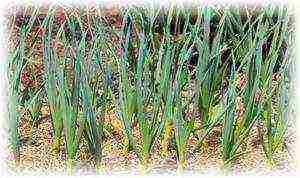 Garlic — unpretentious culture, which does not require special care after it has been planted in the ground. The summer garlic harvest is most abundant in areas where legumes or zucchini were previously planted. A poor vegetable harvest can be seen in the area where potatoes and tomatoes were previously grown.
Garlic — unpretentious culture, which does not require special care after it has been planted in the ground. The summer garlic harvest is most abundant in areas where legumes or zucchini were previously planted. A poor vegetable harvest can be seen in the area where potatoes and tomatoes were previously grown.
Planting and caring for summer garlic is best in spring. The variety tolerates well the storage process until the next harvest. The summer variety does not differ from the winter variety in terms of the content of micronutrients. These are high-quality seedlings that fit perfectly into the menu of people who follow a healthy lifestyle.
General sowing rules
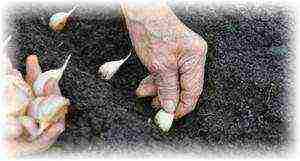 Garlic grows well in moderately moist soil. The culture does not require deep laying of the lobules, since the earth is carefully compacted, and it will be difficult for the plant to break through. The holes for the vegetable should be about 8 cm. Sand can be poured into the bottom 1.5 cm high. Summer garlic heads are planted sprouting down, vertically or sideways.
Garlic grows well in moderately moist soil. The culture does not require deep laying of the lobules, since the earth is carefully compacted, and it will be difficult for the plant to break through. The holes for the vegetable should be about 8 cm. Sand can be poured into the bottom 1.5 cm high. Summer garlic heads are planted sprouting down, vertically or sideways.
Tip: The soil should be nourished after the first greens of the plant appear. Nitrogen-containing components are used as fertilizer.
Fertilizers are diluted according to this ratio: urea and compost are taken for 10 liters of liquid. All of these active additives are combined in 1 tsp. Top dressing is carried out according to the following calculation: per 1 sq. meter needs 3 liters of nitrogen.
Planting should be carried out in early May, as this is the most suitable period for the recovery and formation of stems and heads of agriculture.
Pests and diseases
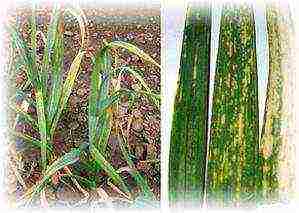 During the vegetative period, the arrows of summer garlic are prone to damage by putrefactive bacteria and yeast pathogens.
During the vegetative period, the arrows of summer garlic are prone to damage by putrefactive bacteria and yeast pathogens.
The striking factor of the vegetable is the appearance of brown dots on the slices, after which the damaged areas become soft and wrinkled.
Downy mildew is a distributor of fungal spores that infect arrows and part of the root system. The arrows, shrinking, do not allow the garlic cloves to develop further, and during harvesting, one can observe underdeveloped heads of an irregularly shaped vegetable.
Tip: The main signs of plant disease are darkening of the arrows and rot of the root system. The culture exudes an unpleasant smell of decay, changes color abruptly, becomes completely unsuitable for
White rot affects larch, after which it turns yellow and falls off. The root system is affected by the fungal knotweed - mycolia, which makes summer garlic unusable.
Black mold is a fungal infection that looks like a black putrid mixture. This disease destroys the crop, moving from one plant to a healthy one.
Preventive measures
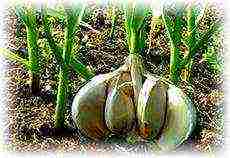 Crop care in order to avoid diseases consists in the selection of seed and its processing with agrochemicals. During the ripening of the culture, it is recommended to inspect the plants, and if damaged units are found, remove them from the garden.
Crop care in order to avoid diseases consists in the selection of seed and its processing with agrochemicals. During the ripening of the culture, it is recommended to inspect the plants, and if damaged units are found, remove them from the garden.
Of the garden pests that infect this culture, one can note the onion fly and its larvae, the garlic mite. Caring for garlic in this case involves spraying the plant with a homemade remedy based on chicory and calendula..
Fertilizing the soil and processing the seed
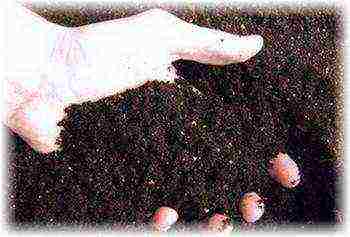 Excavation work on the preparation of summer garlic cloves for sowing should be carried out in advance, so that the soil is compacted a little. During the period of plowing the garden, compost and nitroammophoska are introduced into the holes. Saltite-containing preparations are used in the spring, they are not introduced for the winter. If in the fall preparatory work was carried out for sowing in the spring, then planting requires passing along the ground with harrows or rakes the day before.
Excavation work on the preparation of summer garlic cloves for sowing should be carried out in advance, so that the soil is compacted a little. During the period of plowing the garden, compost and nitroammophoska are introduced into the holes. Saltite-containing preparations are used in the spring, they are not introduced for the winter. If in the fall preparatory work was carried out for sowing in the spring, then planting requires passing along the ground with harrows or rakes the day before.
Planting the garlic heads in the wells means pre-selecting only the healthiest and intact cloves. Large or medium sized heads are most suitable for planting. Before they are lowered into the ground, degreasing and clipping with manganese or vitriol should be carried out. Soaking in the solution should not exceed 15 minutes. Such care contributes to the plant's resistance to viral and infectious lesions.
During the germination period, summer garlic must be fed twice. In the month of May, ending in early June, caring for the plant requires watering once every week. Planting a vegetable in a hole with nitrogen is done during the period of tying garlic cloves.
Tip: Compost that has been added in advance should not be shoveled, as the core of the garlic will not be able to feed from it. You can return the vegetable to its original place of growth only after 4 years.
In addition to nitrogenous substances, phosphorus-containing components can be added. To dilute the solution, you will need 10 liters of water and 2 tbsp. tablespoons of phosphate-nitrogen. The composition is poured into the soil under the root of the culture, calculating a portion of 5 liters per 1 sq. meter. Remove yellowed or cracked workpieces from the total sowing mass.
It is also important to carry out sorting, during which the large and small heads of garlic must be separated. Large slices are planted separately from small ones. The planting time for the summer crop variety is the third week of April, in the interval between April and May.
Landing features
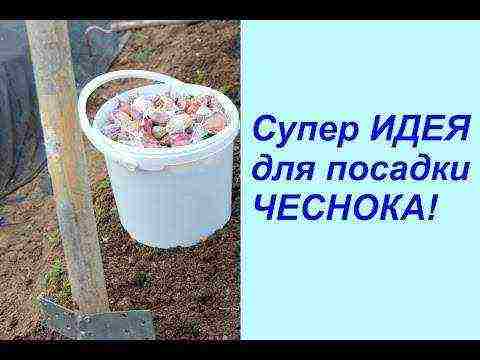
Garlic rows should be no more than 15 cm high and 90 cm wide. Before sowing, a number of work is required to equip the soil with mineral components.
Planting is done so that from the top of the stem to the beginning of the growth of the prong there is no more than 2 or 3 cm. If you plant deeper, it will take more time for the heads of garlic to ripen. The distance between the garlic heads should be 8 cm, and between the rows - 20 cm.
Planting garlic cloves provides for preliminary disinfection of the material with vitriol solution or ash liquor. The planting of each clove is carried out separately, that is, one clove is placed in one hole. The germination area should be light with sufficient air passage. A little sand can be poured into the bottom of the holes, and slices can be buried in it. Planting plants does not need to moisten the earth.
Harvesting
To harvest a bountiful harvest, it is important to adhere to all the rules for planting and caring for this plant. If you do not take timely care of the crop, the harvest will be poor.
Tip: The irrigation process is carried out after a while, after the first shoots break through. During the ripening process, the garlic requires special care - it is necessary to remove the weeds between the rows every two weeks.
 You can often water the vegetable in case of drought. The summer variety does not produce arrows. To determine the degree of ripening, they look at the leaves and their condition: when they fall to the ground and turn yellow, the vegetable can be dug out. This work is done with a shovel or small forks. The ground that has lingered on the teeth cannot be beaten off with a shovel, it is better to do this with a glove. This must be done carefully, since the affected garlic heads will not be stored for a long time.
You can often water the vegetable in case of drought. The summer variety does not produce arrows. To determine the degree of ripening, they look at the leaves and their condition: when they fall to the ground and turn yellow, the vegetable can be dug out. This work is done with a shovel or small forks. The ground that has lingered on the teeth cannot be beaten off with a shovel, it is better to do this with a glove. This must be done carefully, since the affected garlic heads will not be stored for a long time.
Harvesting is allowed in July and August, the further finding of the garlic heads in the ground will lead to cracking of the bulbs and rotting of the vegetable. If the weather is warm outside, caring for the crop consists in drying it. For this, the vegetable is laid out in rows in the sun. After the final drying of the vegetable, it is harvested, the leaves are completely removed and hung in a net in a warm room.
The storage of the summer variety can be either cold or warm. The cold storage method is carried out indoors at -30C. Warm storage - indoors at + 170C. Competent care of agricultural crops will allow you to get a rich harvest of summer garlic with a mild taste.
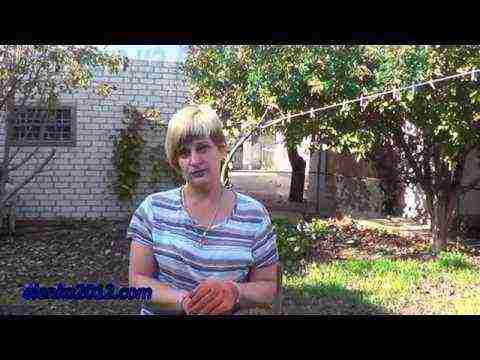
Summer garlic is best planted in areas where legumes or cabbage used to grow.Summer garlic prefers land where pumpkins or cucumbers used to grow. You cannot plant summer garlic on land where potatoes or tomatoes used to grow. Infectious contamination is possible.

A plot with fertile soil is selected for summer garlic. The area must be dry. Garlic loves the sun, so you shouldn't plant summer garlic in the shade. The garlic bed should be no more than 15 centimeters high. And the width is no more than 90 centimeters.
Fertilize the soil before planting. Garlic is planted so that from the surface to the top of the prong is no more than 2 or 3 centimeters. If you plant it deeper, it will mature much later. A distance of 6 or 8 centimeters is left between the teeth. Between the rows of garlic - from 20 or 25 centimeters.
Before planting, garlic is disinfected with either copper sulfate or ash lye. Before planting garlic, it must be sorted. The bulbs are divided into prongs. Sick teeth, cracked, fused or with two tops are discarded. The last two are degenerate garlic. Then the garlic is sorted by size.
Large cloves of garlic are always planted separately from medium to small cloves. In turn, medium and small garlic are also seated separately from each other.
The timing of planting summer garlic is the third decade of April, in the interval from April 20 to April 25. Garlic is always planted in moist soil.
During planting, the teeth should not be pressed into the ground, because the soil as a result is compressed, compacted. In the compacted earth, the roots of garlic grow poorly, slowly. Grooves are made before planting. The depth of the groove should be no more than 8 centimeters. The bottom can be covered with sand, the layer of which should be 1.5 cm thick. No more. The prongs are planted either with the bottom down, vertically, or the prong is placed sideways.
When the plant has its first shoots, it must be fed. For this, nitrogen fertilizer is used. Prepare it as follows. For ten liters of water, take urea, one spoon, a glass of mullein .. Let's clarify, the spoon is a table spoon.
Urea and mullein must be diluted in water. Plants are fed based on the calculation - three liters of fertilizer per 1 square meter. They are fed twice during this period. The second time after 10 days.
Throughout May, and then in June, the plant is watered at least once a day every five or six days. This is due to the fact that the soil at this time must retain moisture. Garlic needs to be fed during the time when the bulbs are forming. At the very beginning of this period, the plants are fed with phosphorus-potassium fertilizer.
To prepare the solution, take 10 liters of water. Stir double superphosphate, two tablespoons, of course, tablespoons. Add 1 spoon to the potassium solution. You can add a spoonful of potassium chloride instead. Fertilizer is applied to the soil at the rate of 5 liters per 1 square meter. After 10 days, this solution is added to the soil again. Wood ash is poured in between.
Garlic is harvested starting from the third decade of August. Cleaning usually begins on August 20 and ends on September 10.
The first sign that the garlic is ripe is massively dried lower leaves. Another sign that the garlic is ripe is yellowed, lodged upper leaves. After harvesting, the garlic must be dried. To do this, garlic is laid out right on the garden bed. The decomposed garlic is left to dry. Drying time is from 6 to 8 days. After the garlic has dried, it is harvested and the stalks are cut. After trimming, the left neck should be no more than 4 or 5 centimeters long.
Store summer garlic either cold or warm.
With the cold method, the temperature is maintained at no more than 3 degrees, but below 1 degree of heat. When warm - 17 or 18 degrees.

